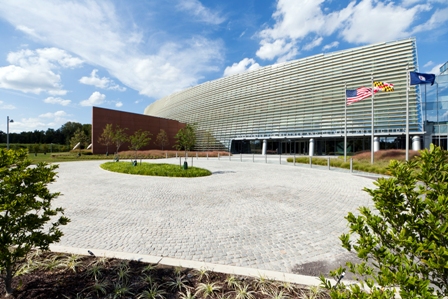
More than six years after ground was broken—and after a nearly two-year construction stoppage—the federal government officially opened the new NOAA Center for Weather and Climate Prediction at the University of Maryland’s M Square Research and Technology Park last week (October 15). The 268,762-square-foot, four-story building is now home to more than 800 NOAA scientists, data managers and other employees. The agency’s National Centers for Environmental Prediction; Satellite, Data and Information Service; and Air Resources Laboratory all are housed in the Energy Star–certified structure (which also is expected to achieve LEED-Gold certification). The building, which was designed by Hellmuth, Obata + Kassabaum (HOK), contains office space, laboratories, a data center, a deli, a 500-seat auditorium and a four-story atrium, as well as a 685-car garage.
When fully built out, the 130-acre, 2 million-square-foot M Square—a public-private partnership between the university and Corporate Office Properties Trust—will be Maryland’s largest research park. Other federal agencies with facilities at the park, which is adjacent to the College Park/UMD Metrorail station, include the USDA Animal and Plant Health Inspection Service (APHIS), the FDA Center for Food Safety and Applied Nutrition (CFSAN) and the Intelligence Advanced Research Projects Activity (IARPA).
Developer Opus East broke ground on the NOAA building on March 13, 2006, but trouble erupted several years later in response to the government’s request that the develop fund more than $30 million in additional building improvements. Though GSA would have re-paid the funds upon lease commencement, they would not agree to make progress payments and, with capital markets in a death spiral, the project’s lenders were unwilling to go along.
Opus East stopped construction in 2009 and, that May, sued GSA for more than $37 million in disputed change orders and payments. (At the time, the building’s shell and interior were 90 percent and 50 percent complete, respectively; the original agreement called for the developer to pay for the shell and GSA the interior.) Opus East officials cited the NOAA project dispute and lawsuit as one of the factors leading to the company’s filing for Chapter 7 bankruptcy liquidation two months later.
The Opus East lawsuit eventually was dismissed, lead lender Bank of America took over the building and Douglas Wilson Companies was named as the court-appointed receiver. On March 7, 2011, GSA signed a new lease and construction agreement, and construction resumed the following month with Skanska USA as the contractor. (Opus East had acted its own design-build contractor, with HOK as architect). Under the new contract, HOK returned as the project’s lead design and interior architect; most of the original subcontractors also returned. Later in 2011, Acquest Development took over the project and was given permission to purchase the mortgage note from Bank of America. In March 2012, Acquest secured nearly $72 in funding for the project from Bostonia Partners, enabling it to complete construction.
